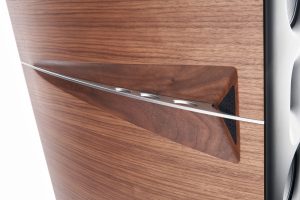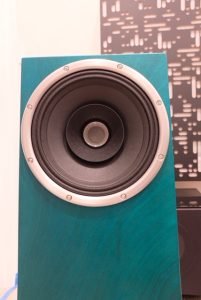Roger Skoff at the 2023 Los Angeles and Orange County Audio Society Gala (portrait and image processing by David W. Robinson)
Roger Skoff writes about how to save money on great sound
Of all the components of your system, the likely most expensive are the speakers and, almost certainly, the most expensive part of building great speakers is getting them to make great bass.
There are a number of reasons why that is. The first and most obvious is that to make bass as deep, loud, and powerful as the music requires means moving lots of air (remember that sound is just air in motion), and that moving air in the quantities necessary either calls for a lot of small drivers moving together over small distances, one or a number of small drivers moving over a relatively long distance, or one or more big drivers doing the same thing.
No matter how you do it, though, good bass is expensive.
Regardless of the number of drivers you use, or of what size they may be, two things are always certain: One is that, at bass frequencies, the air moved by the back(s) of the driver(s) will – unless you do something to prevent it—tend to cancel out the air moved by the front(s) of them, and bass sound will be lost. And the other is that, even if only for looks or to prevent clutter, you're going to have to mount the driver(s) on or in something.
Even just a flat board will work, and if the board is big enough it will, just by its presence, stop bass cancellation. The rule is simple; just make the board as long from the center of the driver to the board's edge in every direction as the half wavelength of the lowest frequency you want to be able to hear, and it will work just fine. It does have its limitations, however: To maintain a 20Hz frequency response, for example, the board would have to extend 27 ½ feet in every direction from the center of the driver to its edge, so just using a big board as an (effectively) "infinite baffle" may not be practical in most cases.
Fortunately, the "board" doesn't have to be straight; all that matters is that it keeps the air from the back of the drivers from cancelling the air from the front. And to do that, all you need is a big, closed box. (Called, incidentally, an "infinite baffle" enclosure.) The box can still need to be big, depending on how deep you want the bass to go and on how many of what size of drivers you're using, but it doesn't have to be huge. (The Bozak B-310, for example, made real 24 Hz bass from four 12 inch drivers in a box of just 14 cubic feet.)
Or, you can actually use the box (the "enclosure") to "trick" the driver into making deeper bass from less space by cutting a carefully calculated hole in one of its sides (a "tuned port"), to make it into a "bass reflex" enclosure. This uses resonance effects to force the back wave of air motion to combine with, (instead of canceling), the front wave from the driver(s) at a particular (tuned) frequency, to actually boost the bass response over a particular range.
Horn loaded enclosures—like the acoustic megaphones they used to use before there were electric bullhorns—can also boost the effective output of a bass driver but, in order to get down to heart-thumping frequencies, they either have to be huge or be placed in the corner of the room.(to use the walls of the room, itself, as extensions of the horn and make for deeper bass). Even then, however, because of the physics they work on, horns may still have difficulty getting down into the really deep bass range. The best of the classic horn speakers (the Lansing Hartsfield, The Klipschorn, and the Electro-Voice Patrician)—even using woofers as large as 30 inches in diameter— although loud, never went much below 35Hz.
Many other approaches have been taken to improve bass performance, but they're all expensive, either because of the special drivers, special equalization, or special built-in bass-only amplification they require, or because of extra expense in building the bass-related parts of the enclosures.
Because of material and labor costs, even flat black boxes (like those used for many "pro" speakers), are expensive to build. And, when the box needs extra-heavy, anti-resonant walls and elaborate internal structure or bracing (as do virtually all High-End, horn, or transmission line speakers—a "transmission line" is another very complex and costly way to deal with the woofer's back wave), it can get very expensive, indeed. And then, when cosmetic appeal is added to justify the speaker's high cost, we find ourselves looking at what we have so many of, these days—speakers far more expensive than the majority of music lovers or audiophiles can either afford or are willing to pay for.
Fortunately, there IS a solution. Most speaker manufacturers offer both "bookshelf" (anything small or stand-mounted) and larger, floor-standing models. These can be either two-way (woofer and tweeter only) or three-way designs (woofer, midrange, and tweeter), and, in most cases, other than the woofer, all of the drivers—the things that actually make the sound—are the same from model to model. Not just the same size, but actually the same drivers. It's usually just the size, the kind, and the number of woofers and their related crossover section that changes. That, plus, of course, the bass-connected aspects of the enclosures they come in. The rest of the speaker remains the same.
And it's that, plus the fact that woofers don't necessarily have to be located in the same places as the mid-range or tweeter drivers for the two channels that allows you to get possibly even better sound by buying speakers the way I'm about to suggest to you than if you were to buy them in the conventional way.
The fact is that bass frequencies, because of their long wavelength, don't localize very well. As a result, woofers can be set just about anywhere in most listening rooms without them influencing your system's imaging. You can even (if you want or need to) get a free bass boost by setting your woofer next to a wall. Or get an even bigger one by placing it in a corner.
With the tweeter and midrange drivers, it's a different thing altogether. Sound from them does localize easily, and is the key to your speakers' ability to image properly and project a believable soundstage. Unless they are positioned properly, (tweeter and midrange together for each channel and the speakers for both channels positioned properly relative to each other and to the walls of the listening room), your system will never be able to perform to its full capability.
Unlike bass, midrange and treble sound doesn't require any help from the enclosure to produce sound, so, given the same great drivers as their floor-standing counterparts, small, stand-mounted speakers have no disadvantage in producing full, believable sound. In fact, they might even have an audible advantage: large drivers require large boxes, just to fit in. This can make for a broader "face" on the speakers, just to hold the large drivers, and can because of their width, cause problems of diffraction off the enclosure's front which will affect the speakers' ability to image. With smaller boxes being used for stand-mount two- or three-way speaker systems, frontal area can be reduced and there can be a clearly audible improvement to their reproduction of music's spatial and directional characteristics.
So, given all that, what do I recommend that you do?
Instead of paying more money and taking up more listening room space (and possibly facing Wife Acceptance Factor problems because of two big speakers dominating your listening room's décor), buy high performance stand-mount speakers from a top manufacturer, and use a part of your savings from not buying the larger speakers to pay for a single high-performing powered subwoofer. Because the subwoofer can be put somewhere inconspicuous, you may even be able to save more money by buying it in flat black instead of some more expensive finish. Then set the sub's internal crossover so that it takes over from the woofers in the other speakers somewhere in the 60 to 100Hz range. That will give you the deep bass you want and, because you won't be using it, make the limited bass response of the stand-mount speakers irrelevant. It won't matter because they'll just be acting to help the subwoofer, not to carry the bass load by themselves.
If you do that, you'll have great-sounding, great-imaging speakers with plenty of strong, dynamic bass, a happy wife, and more moving-around space in your listening room. Better yet, you might still have money left in your pocket.
And that's the bottom line.






































